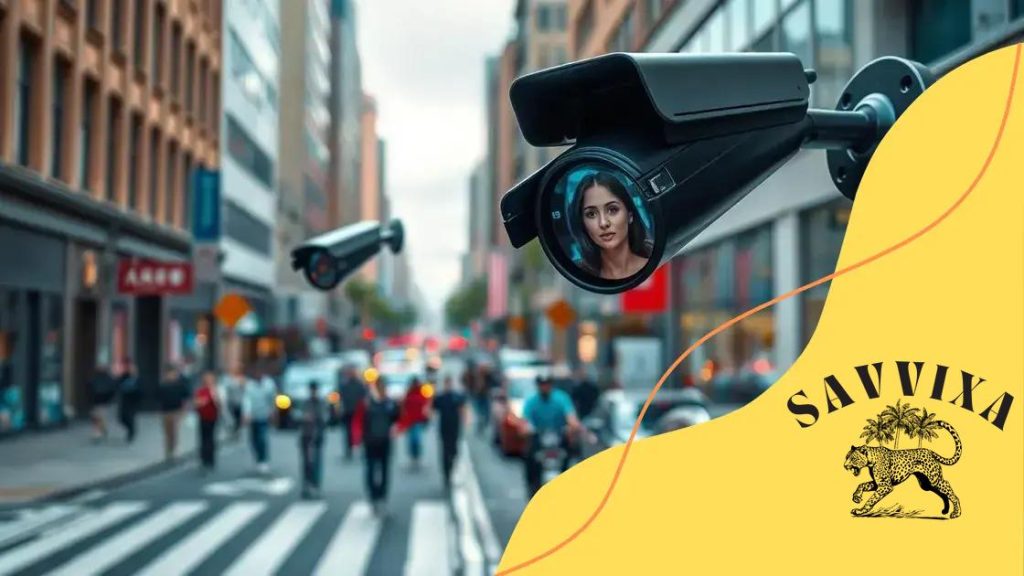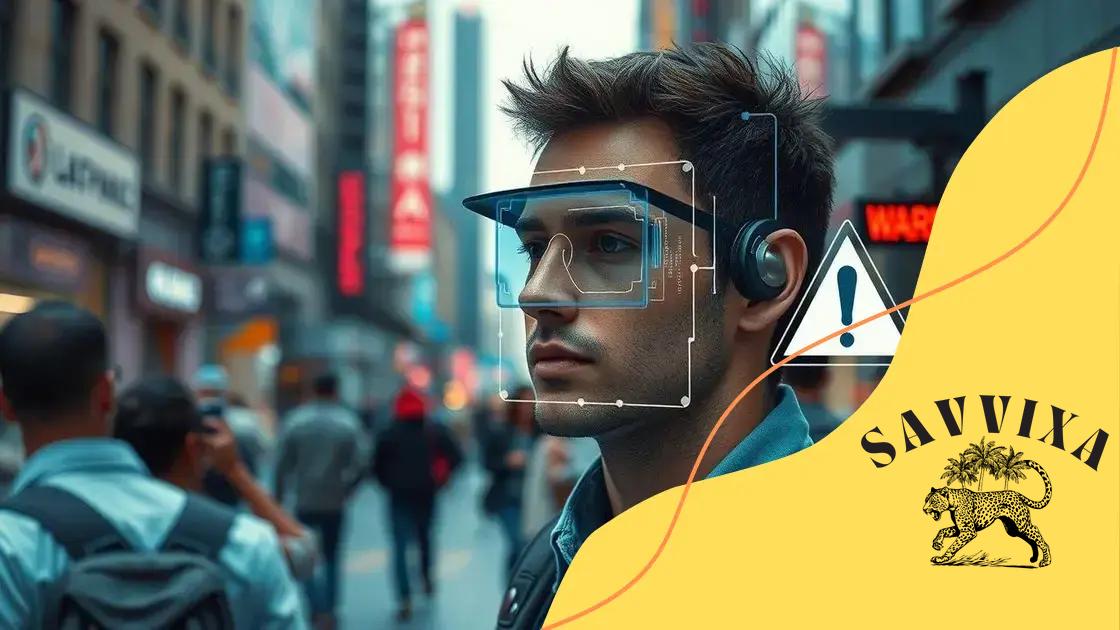The role of facial recognition in enhancing public safety

The role of facial recognition in enhancing public safety includes improving security through real-time identification of individuals and addressing important privacy and ethical concerns associated with its widespread use.
The role of facial recognition in enhancing public safety continues to evolve, sparking debates on its effectiveness and ethical use. Have you considered how this technology will shape our communities? Let’s dive in.
Understanding facial recognition technology
Understanding facial recognition technology is essential in our modern world. This technology uses algorithms to identify faces in images or videos. Many people have seen it in action, but few understand how it works behind the scenes.
The process begins with capturing an image. This could be from a surveillance camera or a smartphone. Once the image is captured, the software scans it for unique features of a person’s face. These features include the distance between the eyes, the shape of the jawline, and the contours of the cheeks.
How Facial Recognition Works
This technology relies on sophisticated algorithms to analyze and match faces. Here’s how it typically operates:
- Image Capture: The initial step involves taking a clear photo or video of a person’s face.
- Feature Extraction: The software examines the image using patterns and features.
- Comparison: The extracted features are then compared to a database of known faces.
- Identification: If there’s a match, the system confirms the identity of the individual.
Currently, facial recognition technology has numerous applications. It is widely used in security systems, airports, and even smartphones for unlocking devices. In addition to security, this technology helps in locating missing persons or identifying criminals.
Benefits and Limitations
While the advantages are clear, there are also limitations to consider. For instance, factors like lighting, angle, and image quality greatly affect accuracy. Moreover, privacy concerns arise as the technology collects personal data. Many argue that it can lead to surveillance overreach.
Despite the challenges, the potential for facial recognition technology to enhance public safety is significant. As systems improve, they may become more reliable and efficient. Understanding the balance between safety and privacy is crucial as this technology becomes more prevalent in our society.
Benefits of facial recognition for public safety
The benefits of facial recognition for public safety are becoming increasingly clear in today’s world. This technology enhances security measures by allowing quick and accurate identification of individuals. Many public places, such as airports and stadiums, use this technology to help maintain safety.
One major advantage is its ability to reduce crime rates. By deploying facial recognition in high-traffic areas, authorities can quickly spot wanted criminals or individuals involved in suspicious activities. This instantaneous identification often acts as a deterrent to potential offenders.
Key Advantages
There are several key advantages to using facial recognition technology for public safety:
- Rapid Response: Security personnel can respond faster to incidents by identifying individuals on watch lists.
- Enhanced Surveillance: Wide-ranging surveillance systems can cover more ground when combined with facial recognition.
- Data Collection: This technology can gather data to analyze crime patterns and help in future prevention efforts.
- Improved Emergency Response: In case of emergencies, swift identification can assist first responders in their actions.
In addition to these benefits, facial recognition can also improve the overall experience in public spaces. For example, it can streamline processes like entry into events, making it easier for attendees. Similarly, in airports, it can speed up check-in processes, enhancing passenger flow.
Community Safety
Another important aspect is community safety. By integrating facial recognition systems, communities can monitor neighborhoods more effectively. Local authorities can collaborate with technology to take a proactive stance on crime prevention.
Moreover, facial recognition aids in identifying missing persons, offering hope to families and the community. Such real-life applications highlight the potential for this technology to make a positive impact in everyday life.
Potential privacy concerns with facial recognition

As the use of facial recognition technology grows, so do the potential privacy concerns associated with it. Many people are becoming increasingly aware of how their images might be captured and analyzed without their consent. This technology can identify individuals quickly, raising questions about surveillance and personal privacy.
One of the primary concerns is the potential for misuse of data. Facial recognition systems can collect vast amounts of information, which, if improperly managed, could lead to abuse. For instance, unauthorized access to databases can allow individuals or organizations to track movements and behaviors.
Key Privacy Issues
Here are some key privacy issues related to facial recognition technology:
- Surveillance Overreach: Continuous monitoring in public spaces can lead to an invasion of privacy.
- Lack of Consent: Many people are not aware that their faces may be scanned without permission.
- Data Security Risks: If databases are hacked, sensitive information could be exposed.
- Bias and Inaccuracy: Facial recognition systems can sometimes misidentify individuals, which may lead to unfair treatment.
Additionally, many worry about the implications for freedom of expression. If people know they are being constantly watched, they may hesitate to participate in public demonstrations or events. This can stifle dissent and reduce civic engagement in society.
Balancing Safety and Privacy
Balancing safety and privacy is a significant concern. As law enforcement agencies adopt facial recognition, they must also consider ethical guidelines. Developing strict regulations can help protect citizens while still allowing the technology to enhance safety efforts.
Moreover, transparency is crucial. Authorities should inform the public about how facial recognition systems operate and what data is collected. This open dialogue can help build trust between the community and organizations implementing this technology.
Real-world applications and case studies
Real-world applications of facial recognition technology are rapidly expanding across various sectors. From security to customer satisfaction, many industries are discovering how this technology can enhance operations.
In law enforcement, facial recognition plays a crucial role in identifying suspects. Police departments around the world are using this technology to solve crimes more efficiently. For example, by analyzing surveillance footage, they can quickly match faces against databases of known offenders, leading to faster resolutions.
Applications in Different Sectors
Facial recognition is not just limited to law enforcement. Here are some prominent applications:
- Security: Airports and stadiums utilize facial recognition to identify potential threats, ensuring the safety of large crowds.
- Retail: Stores use this technology to track customer behavior and personalize shopping experiences, enhancing customer service.
- Healthcare: Hospitals implement facial recognition for patient identification, reducing the risk of errors in treatment.
- Transportation: Some transit systems use facial recognition to streamline ticketing and enhance security measures.
Moreover, several organizations have shared success stories where facial recognition significantly improved safety and efficiency. For instance, a large airport reported a decrease in unauthorized access after implementing advanced facial recognition systems. This technology allows security personnel to monitor multiple entry points simultaneously, which enhances overall monitoring capabilities.
Case Studies
Case studies show the varying impacts of facial recognition. In one city, a pilot program allowed police to use this technology during major events. The results were quite positive, with a reduced incidence of crime compared to previous years.
Another notable case was in retail, where a national chain adopted facial recognition to analyze foot traffic. They found that understanding customer flow improved store layout and merchandising strategies, leading to increased sales.
These examples illustrate how effectively facial recognition technology can be applied in real-world scenarios, providing significant benefits while also encouraging discussions about ethics and privacy. As the technology continues to evolve, more applications will likely emerge, shaping the future of various industries.
Future implications of facial recognition in society
The future implications of facial recognition in society are vast and complex. As this technology becomes increasingly integrated into our daily lives, it is essential to consider both its benefits and potential challenges. With advancements in artificial intelligence, the accuracy and efficiency of facial recognition technology are expected to improve, leading to broader applications.
One significant implication is how businesses and government entities will use this technology. The ability to quickly identify individuals can enhance security in public places, making cities safer. However, as we embrace these advancements, we must also address privacy concerns surrounding the use of facial recognition.
Potential Societal Changes
As facial recognition technology evolves, several societal changes may occur:
- Increased Surveillance: Public spaces could see heightened monitoring, leading to debates about the balance between safety and privacy.
- Enhanced Personalization: Businesses might use this technology to create tailored experiences for customers, potentially leading to improved customer satisfaction.
- Job Market Shifts: As automation rises, certain jobs may become obsolete, while new positions in tech and ethics may emerge.
- Legal Frameworks: New laws and regulations will likely be needed to manage the use of facial recognition, ensuring it is used responsibly.
The integration of facial recognition into daily life could also affect social dynamics. For instance, if individuals believe they are being constantly watched, it may affect their behavior in public. This awareness can lead to changes in how people interact in social settings, possibly causing fear or reluctance to express themselves freely.
Addressing Ethical Concerns
As we look ahead, it’s crucial to address the ethical dilemmas associated with facial recognition technology. Discussions on bias in identification and the potential for misuse should be at the forefront of technological development. Ensuring that facial recognition algorithms are fair and transparent is vital to gaining public trust.
Furthermore, collaboration between technology developers, policymakers, and community stakeholders will be essential. By fostering open dialogue, society can shape a future where facial recognition enhances security without sacrificing individual rights or freedoms.
FAQ – Frequently Asked Questions about Facial Recognition Technology
How does facial recognition improve public safety?
Facial recognition enhances public safety by quickly identifying individuals in real-time, allowing authorities to respond more effectively to potential threats.
What privacy concerns are associated with facial recognition?
Privacy concerns include unauthorized data collection, potential misuse of personal information, and increased surveillance in public spaces.
Are there legal regulations governing facial recognition technology?
Yes, many governments are developing laws and regulations to ensure the responsible use of facial recognition technology and protect individual privacy rights.
What are the future implications of facial recognition in society?
The future implications may include changes in social dynamics, enhancements in security measures, and ongoing discussions about ethics and privacy regarding surveillance.